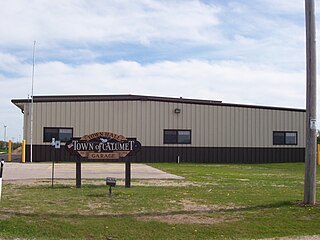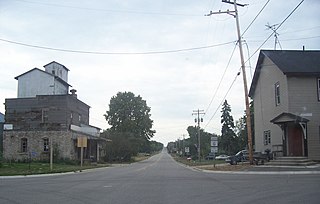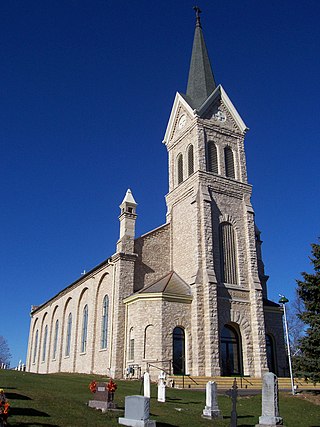
Fond du Lac County is a county in the U.S. state of Wisconsin. As of the 2020 census, the population was 104,154. Its county seat is Fond du Lac. The county was created in the Wisconsin Territory in 1836 and later organized in 1844. Fond du Lac is French for "bottom of the lake", given so because of the county's location at the southern shore of Lake Winnebago. Fond du Lac County comprises the Fond du Lac, Wisconsin Metropolitan Statistical Area. The Holyland region is in northeastern Fond du Lac County.

Calumet County is a county located in the U.S. state of Wisconsin. As of the 2020 census, the population was 52,442. The county seat is Chilton. The county was created in 1836 and organized in 1850.

Calumet is a town in Fond du Lac County, Wisconsin, United States. The population was 1,514 at the 2000 census. The unincorporated communities of Artesia Beach, Calumet Harbor, Garnet, Highland Park, Johnsburg, Laudolff Beach, Marytown, Pipe, Pukwana Beach, Winnebago Heights, and Winnebago Park are located within the town. The unincorporated community of Calumetville is located partially in the town.

Mount Calvary is a village in Fond du Lac County, Wisconsin, United States. The population was 548 at the 2020 census, down from 762 at the 2010 census.

The Eastern Ridges and Lowlands is a geographical region in the eastern part of the U.S. state of Wisconsin, between Green Bay in the north, and the border with Illinois in the south. Lake Michigan lies to the east of the region.

Malone is an unincorporated community located in Fond du Lac County, Wisconsin near the Sheboygan River and Mt. Calvary, in the towns of Marshfield, and Taycheedah. Malone is located in The Holyland region of Wisconsin. It is home to a post office.
Wisconsin's 6th congressional district is a congressional district of the United States House of Representatives in eastern Wisconsin. It is based in the rural, suburban and exurban communities between Madison, Milwaukee, and Green Bay. It also includes the village of River Hills in far northern Milwaukee County. The district is currently represented by Glenn Grothman (R-Glenbeaulah) who took office in January 2015.
The Tri-County News is a weekly newspaper based in Kiel, Wisconsin.

Pipe, Wisconsin is an unincorporated community in the Town of Calumet in Fond du Lac County, Wisconsin, United States. It is located approximately 1 mile (1.6 km) east of Lake Winnebago.

Johnsburg, Wisconsin is an unincorporated community in the Town of Calumet in Fond du Lac County, Wisconsin. The community is located on County Roads Q and W, approximately 3.3 miles (5.3 km) east of Lake Winnebago, 2.75 miles (4.43 km) southeast of Pipe and 1.4 miles (2.3 km) northwest of Malone. Johnsburg is part of the Holyland region in northeastern Fond du Lac county.

Marytown, Wisconsin is an unincorporated community in Fond du Lac County, Wisconsin, in the town of Calumet. Marytown is located at the intersection of Fond du Lac County highways G and HH. Wisconsin Highway 149, ran north to south through the community before it was decommissioned in 2006.

St. Anna is an unincorporated community in Calumet and Sheboygan Counties in the U.S. state of Wisconsin. It lies in the towns of Russell and New Holstein.

The Malone Area Heritage Museum is a historical museum in Malone, Wisconsin, United States. The museum documents the history of immigrants into the Holyland region of Wisconsin. The museum is affiliated with the Wisconsin Historical Society. It has been in existence since 2005. It is open to the public on Thursday afternoons between 2:00 and 4:00 pm and on the second Sunday of each month.

St. Joe is an unincorporated community in the town of Marshfield in Fond du Lac County, Wisconsin, United States. The community is located on County Highway G in the northeast portion of the county, 2.5 miles (4.0 km) northwest of St. Cloud and 3.5 miles (5.6 km) northeast of Mount Calvary. It is considered part of the Holyland.

Charlesburg is an unincorporated community in the town of Brothertown in Calumet County, Wisconsin, United States.

Jericho is an unincorporated community in the town of Brothertown in Calumet County, Wisconsin, United States. Jericho is located at the intersection of County highways C & H. Jericho is part of the Holyland region in Wisconsin.

St. Peter, Wisconsin is an unincorporated census-designated place in the Town of Taycheedah in Fond du Lac County, Wisconsin. It is located approximately 2 miles (3.2 km) northeast of Peebles and 1 mile (1.6 km) south of Silica. It was located on Wisconsin Highway 149 before the highway was decommissioned and turned over to county control as County Highway WH. As of the 2010 census, its population is 1,489.

Calvary, Wisconsin is an unincorporated community located in the town of Marshfield, in Fond du Lac County, Wisconsin. The community was originally known locally as Calvary Station since the community was built around the railroad depot for Mount Calvary. The depot for the Sheboygan-Fond du Lac Railroad needed to be built about 1 mile (2 km) north of the community because of the grade needed for trains to climb the Niagara Escarpment. It is located at the intersection of County Highways WW and WH. It is located in the heart of the Blue Sky Green Field Wind Farm in Wisconsin's Holyland Region.
The 1st Senate District of Wisconsin is one of 33 districts in the Wisconsin Senate. Located in northeast Wisconsin, the district comprises all of Door and Kewaunee counties, as well as nearly all of Calumet County, much of northern and western Manitowoc County and eastern and southern Brown County, along with parts of southwest Outagamie County. It includes the cities of Sturgeon Bay and Chilton and parts of the cities of Appleton, Menasha and Green Bay.

The St. John the Baptist Roman Catholic Church is a Roman Catholic church in Johnsburg in Fond du Lac County, Wisconsin. The church is part of the Roman Catholic Archdiocese of Milwaukee. It was listed on the National Register of Historic Places in 1980.






















